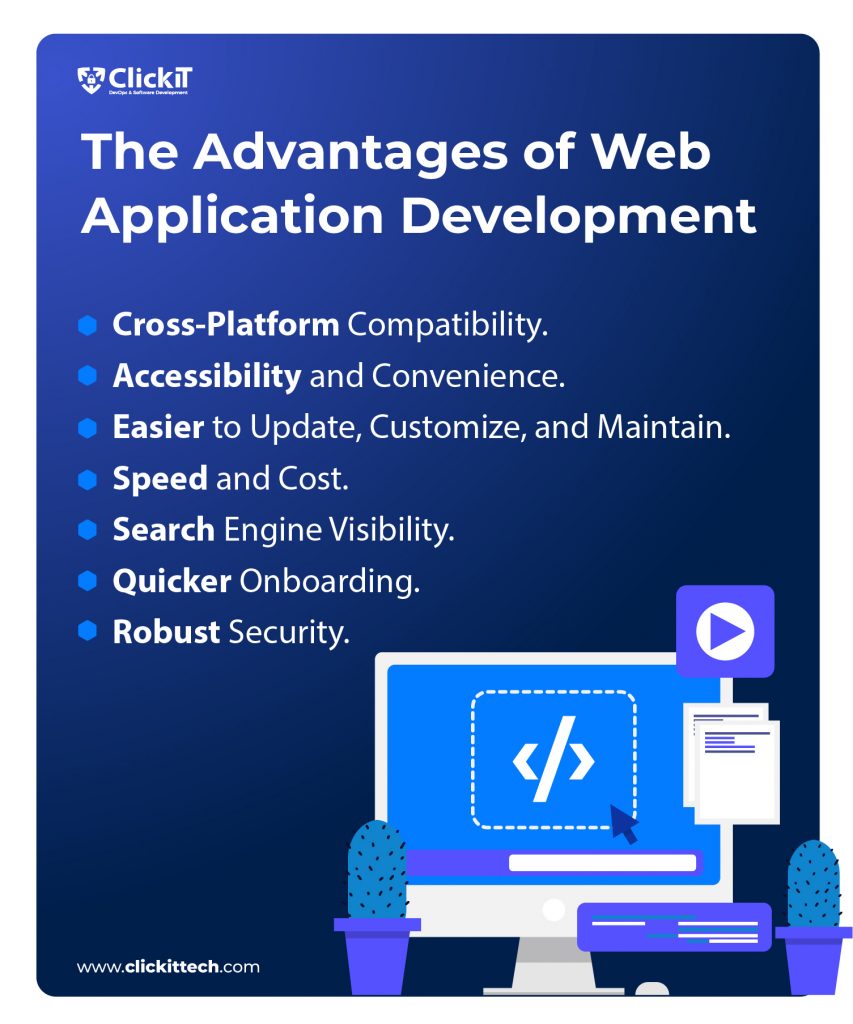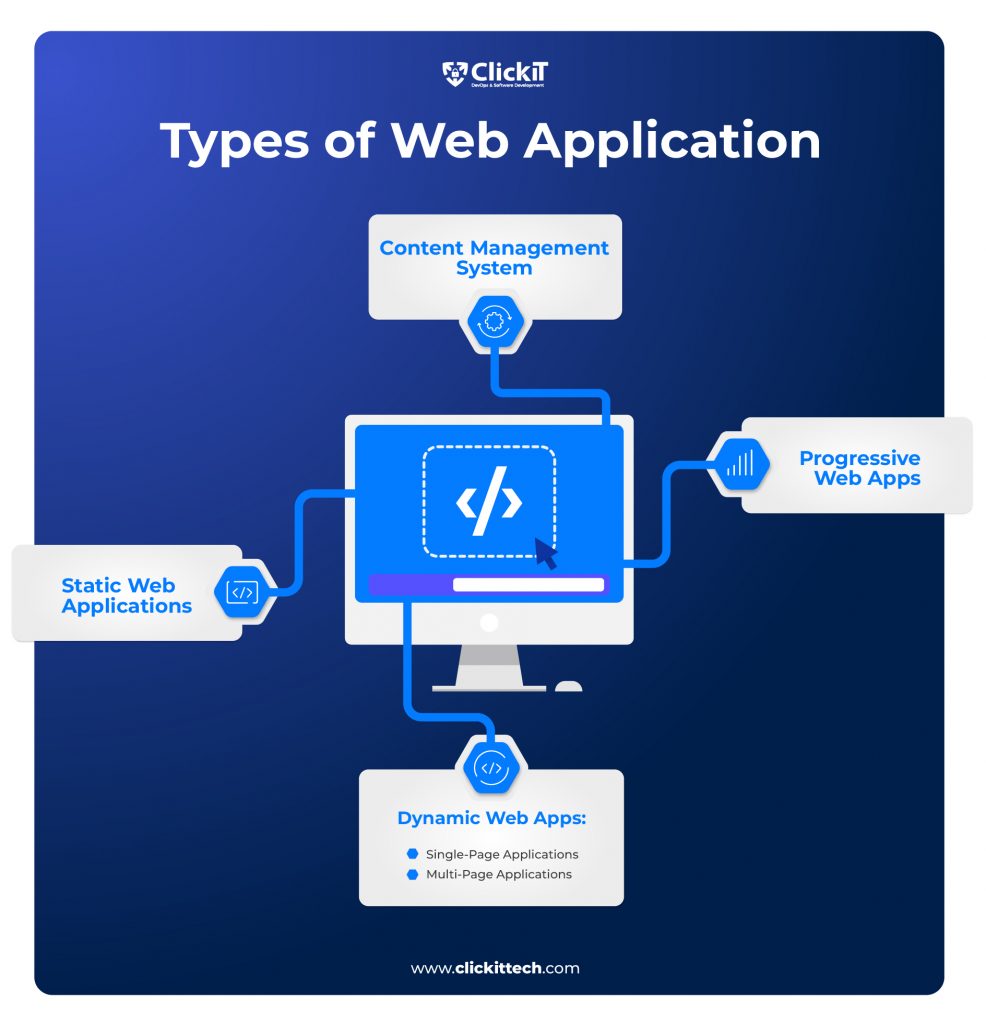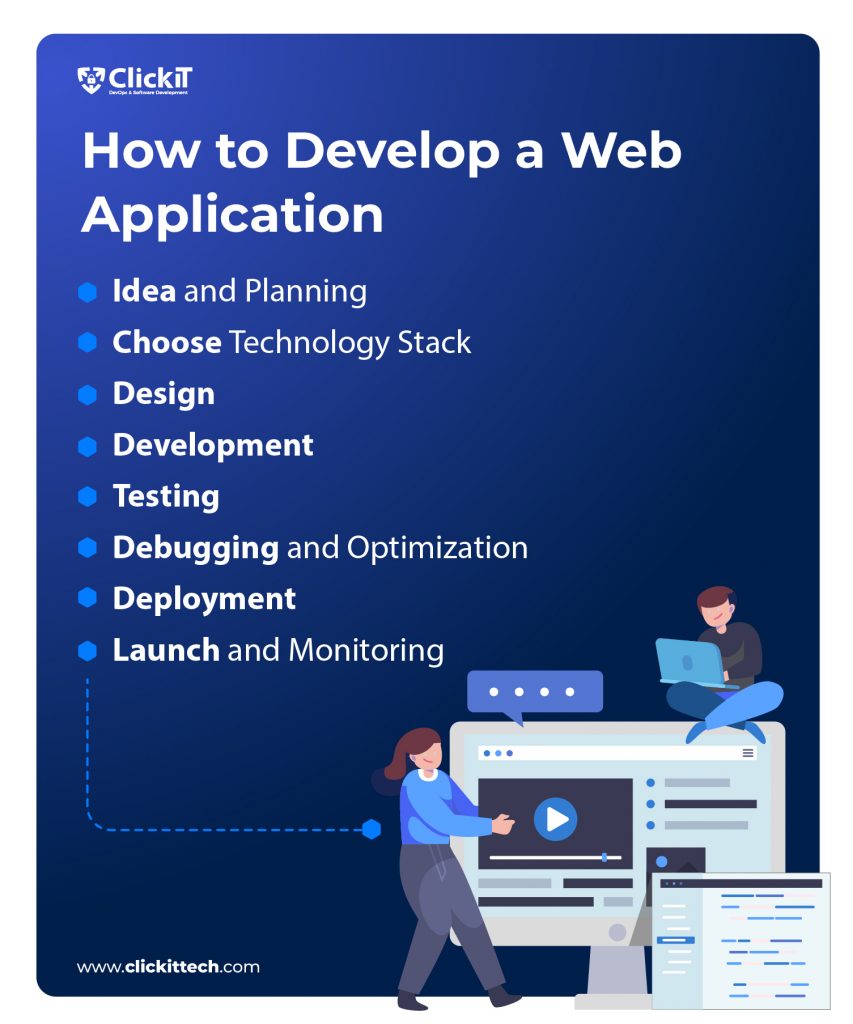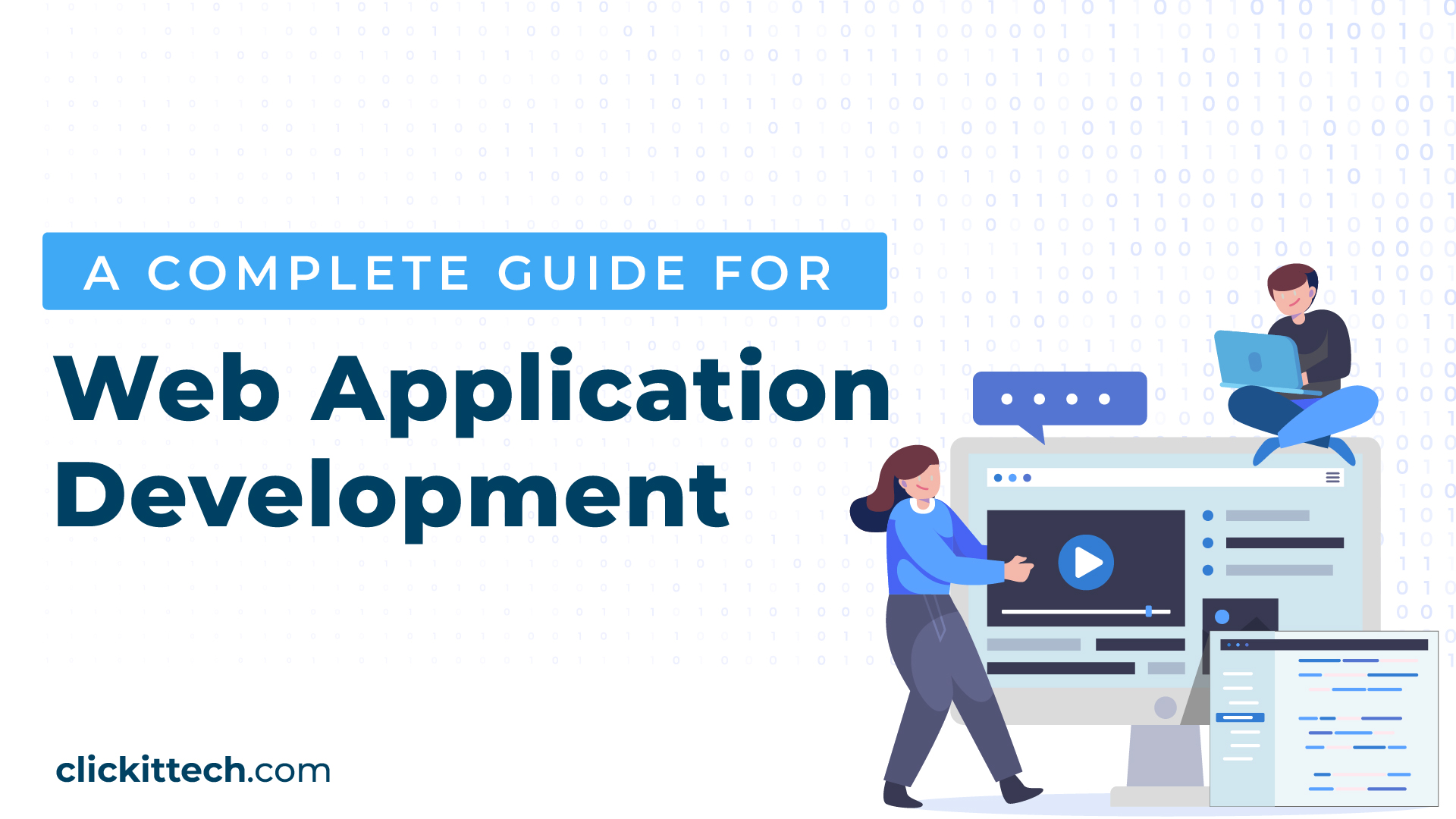Application development web is growing faster than ever, with a projected market volume of $234.70bn by 2028. If you’re considering developing a web app this guide offers an in-depth walkthrough of the entire process.
We have been integrating web apps into our daily routines. For instance, you might use web applications like Google Workspace, Microsoft Teams, Figma, and Zoom at work.
On the other hand, you might be leisurely exploring social media websites such as Facebook and YouTube or perhaps online shopping through Amazon, eBay, or Shopify.
Web application development has evolved over the last few years. Today, web apps have become essential for companies and individuals to gain a competitive edge or establish a solid online presence.
From ideation and design to the testing and launch stage, we’ll cover everything you must know about developing a web application.
Table of contents
- What is Web Application Development?
- Why Develop a Web Application?
- How Does a Web Application Work?
- Types of Web Application Development
- How to Develop a Web Application
- Developing a Web App With ClickIT
- Conclusion
- FAQs
What is Web Application Development?
Web Application Development is the process of building software programs that are accessible through web browsers over the internet. This process involves ideation, designing, building, testing, launching, and maintaining the app.
These applications can be a simple interactive form or a complex platform with carefully designed user interfaces, intricate databases, and real-time functionalities.
Like mobile and desktop apps, web applications must be user-friendly and functional, with robust security and fast load times.
However, security may be even more critical. The 2023 Verizon Report showed that web application attacks accounted for 26 percent of all data breaches. In 2021, a Report on Website Vulnerabilities showed that more than 50 percent of all websites had at least one exploitable vulnerability.
These security concerns could be due to their online nature, which exposes them to unique security challenges. Examples include cross-site scripting (XSS), SQL injection, Distributed Denial of Service (DDoS), and other security misconfigurations.
Additionally, slow web apps can affect user experience and conversion. This leads to higher bounce rates, low conversion rates, and less visibility in search engine results.
Hence, web application development teams must note these factors when building the product.
What are Web Applications?
A web application or web app is a software program that runs on a remote web server or in the cloud.
Think of it as a standard mobile or desktop app with one key difference: rather than download or install it locally, users access the web app via a browser.
This remote accessibility makes web apps versatile and convenient. They enable users to interact with the application’s features and functions seamlessly, regardless of their device’s specifications.
Like all apps, web applications are developed for a specific reason or use. The user enters data through the client-side or front end, while the back end or server-side stores and processes the information.
Why Develop a Web Application?

Application development web has many benefits for enterprises and users. Here are some of them:
- Cross-Platform Compatibility
- Accessibility and Convenience
- Easier to Update, Customize, and Maintain
- Speed and Cost
- Search Engine Visibility
- Quicker Onboarding
- Robust Security
1. Cross-Platform Compatibility
Some web apps may recommend specific browsers or configurations for the best experience. Nonetheless, web applications are generally compatible with web browsers on various devices, regardless of the operating system. Web applications will adapt well, whether on iOS, Mac OS, Android, or Windows devices.
2. Accessibility and Convenience
As long as users have an internet connection and a web browser, they can access web applications from anywhere. This makes web applications portable and convenient for users on the go.
3. Easier to Update, Customize, and Maintain
Improvements to a web app can be deployed centrally on the server. This makes the web app easier to update in real-time, customized to evolving business requirements and user needs, and maintained.
Therefore, users don’t have to download updates separately. These real-time updates and interactions can be particularly useful for messaging platforms, collaborative tools, and applications that require dynamic content.
4. Speed and Cost
developing web app are generally less expensive and faster to deploy when compared to the same project size, features, and complexity on native apps.
5. Search Engine Visibility
Web apps are inherently discoverable by search engines, potentially improving their visibility in search results. This can drive organic traffic and user acquisition.
6. Quicker Onboarding
Besides search engine visibility, users don’t need to download and install a web app, reducing adoption friction. Such quick onboarding can lead to a broader user base and increased engagement.
Since users don’t need to download locally, web apps don’t occupy significant space on their devices. This is excellent for users with limited storage capacity.
The lower cost is primarily due to the web application’s cross-platform compatibility and shared codebase. Moreover, saving development time can accelerate time-to-market.
7. Robust Security
Web applications are commonly hosted on dedicated servers, undergoing continuous monitoring, and overseen by proficient server administrators. This provides more robust security than monitoring hundreds or thousands of client computers.

How Does a Web Application Work?
The web application architecture uses the client-server model with two components: the client-side scripts and the server-side scripts.
Client-side Architecture
The client-side script handles user interface elements like buttons, drop-down menus, forms, animations and effects, etc. When you visit a web app, the web browser runs the client-side script and displays the graphics and text. This means you can see and interact with elements like videos and pictures or read content. When you click on a button, such as “submit”, after filling out a contact form, this goes to the server as a client request.
Server-side Architecture
The server-side script handles data processing. After receiving the client request, the web application server processes it and sends a response. For example, when you enter your login credentials and click “log in,” the server verifies your identity and grants you access. Similarly, when you tap the “submit” button, the server saves your data in the database.
Sometimes, the server may generate the HTML content and send the complete page back to you. This is known as server-side rendering – a process that can improve SEO performance.
What are the Types of Web Application Development?

Web application development comes in different types, each tailored to specific functionalities and purposes. Here are some of the most common types of web application development:
Static Web Applications
A static web application is a website without server-side interactions. As a result, they are mainly used for informational purposes to display predefined content to the user with HTML, CSS, and JavaScript.
They could also have videos, GIFs, and similar media.
Static web apps often display information for simple business or portfolio websites. Other examples of static web apps include documentation sites and event websites.
Dynamic Web Apps
Dynamic web apps are interactive and offer users server-side interaction capabilities. These web apps can generate data in real time, depending on the user’s requests.
Users can also perform tasks like online shopping, uploading content, and chatting in real time.
Examples of dynamic web applications include social media platforms like Facebook and Twitter. eCommerce websites like Amazon, eBay, and Shopify, gaming sites like Steam, and streaming services like Netflix and Spotify fit in the category too.
You’ll notice that these applications can deliver content to users in real time, offer multiplayer capabilities, and adjust recommendations based on past interactions, among other functionalities.
Said elements make dynamic web applications more complex, and their development is often challenging.
Dynamic web apps use a range of programming languages like ASP.NET, PHP, JavaScript, Python, Java, etc. A dynamic web app can be single-page (SPA) or multi-page (MPA).
Read our blog, python frameworks for your web applications
Single-Page Applications
SPAs load a single HTML page and dynamically update the content in response to user interactions without the page reloading fully. This offers a seamless and responsive user experience.
Multi-Page Applications
Multi-page applications have multiple pages, each corresponding to a separate HTML file. In MPAs, navigating from one page to the other requires loading new content from the server. As a result, each page has a different functionality or view.
You can commonly find MPAs in online stores, directories, news sites, enterprise applications, and web portals.
Progressive Web Apps
PWAs combine the best web and mobile applications, enabling offline access, push notifications, and fast loading times, all within a browser.
Also known as cross-platform web applications, progressive web apps are highly developed. Moreover, they can leverage the latest browser APIs to provide a native mobile app experience.
Content Management System
CMS allows users to create, manage, and modify digital content on a website without technical or programming knowledge. Content management systems maintain websites, blogs, and media sources.
WordPress, Joomla, and Drupal are the content management systems most commonly used.
Other types of web applications include rich-internet web applications and portal web apps, among others.
Web Application Development Guide
While each development team may have unique ways to develop a web application, here is a reliable checklist to follow for developing web app.
- Idea and Planning
- Choose Technology Stack
- Design
- Development
- Testing
- Debugging and Optimization
- Deployment
- Launch and Monitoring

Idea and Planning
The first stage of every Software Development Life Cycle, including web application development, is conceptualizing the final product.
This involves strategically aligning your business goals with the purpose of your web application and identifying the specific problem it aims to solve.
To do this, you’d have to identify the target audience and their pain points. Such insight allows you to develop a web application that addresses their needs and preferences directly.
Additionally, you should understand the market niche you intend to enter. This enables you to pinpoint the gaps your web app can effectively bridge.
An essential aspect of this phase entails creating a feature list outlining the functionalities your web app will deliver. The type of app, the market gaps you’re filling, user needs and preferences, and business goals will all influence the feature list.
Choose a partner among the Top Software Development Companies.
Choose Technology Stack
Choosing the right tech stack for web application development directly influences the development process and end product. Your technology stack covers programming languages, frameworks, libraries, and tools you use for development.
This encompasses frontend (client-side) and backend (server-side) components. Ensuring all technologies integrate seamlessly to create a functional, high-quality application that meets user expectations is essential.
Furthermore, you should also consider the type of web app. For example, a static web app or website will require HTML, CSS, and JavaScript.
On the other hand, dynamic web apps may necessitate a broader tech stack. This might include RESTful APIs and WebSockets for real-time communications.
Other factors to consider include scalability, security, developer expertise, cost, third-party integration, and ease of development.
Design
The user interface (UI) and the user experience (UX) design are crucial aspects of the web application development process. It involves creating wireframes or prototypes to visualize the web app’s layout and designing UX flow with usability and user interaction in mind.
While the UX design ensures a seamless and engaging user interaction, the UI design focuses on making the app usable and visually appealing. Additionally, developers work on defining the database schema, which structures the app’s data for efficient storage and retrieval.
Throughout this stage, the challenge lies in balancing functional requirements and user-centered design principles. Collaborative feedback loops, involving stakeholders and even end users, are crucial. Such an iterative process refines the design, aligning it with project objectives and user needs.
The final design documentation and assets serve as a guide for the development team, ensuring accurate implementation. Although the design stage differs, it often overlaps with development, as collaboration is essential to create a well-designed and functional web app.
Development
After validating the prototype in the web application development, it’s time to write the code. Developing a web app often begins with setting the front-end and back-end development environment. This involves configuring the necessary tools and platforms to facilitate smooth development.
The development stage is a critical part of building your web application. Considering that 99.5 percent of consumer apps fail, having the right expertise can make all the difference between a failed or successful app.
ClickIT provides best-in-class software development that ensures the technical excellence of your project needs. From DevOps and software development to staff augmentation and cutting-edge cloud solutions, ClickIT offers a comprehensive package for web app success.
Web app development is nuanced, and here are the phases you’ll go through:
Frontend Development
The frontend development uses fundamental web technologies like HTML, CSS, and JavaScript. Here, web developers write the code for the UI, develop layouts, enhance visual aesthetics, and incorporate interactivity.
On the other hand, developers implement the backend logic using a selected server-side language and framework.
While the frontend development determines the visual and interactive aspects users interact with, the backend development is responsible for the application’s underlying functionality, data processing, and business logic. It ensures that the app operates efficiently, processes user input, and manages data.
HTML5: The standard markup language for creating web pages. It structures the content on the web.
CSS3: Used for styling and layout. CSS frameworks like Bootstrap and Tailwind CSS can speed up development with pre-designed components.
JavaScript: The core programming language for dynamic content, it offers robust options for building complex user interfaces. Some popular frameworks and libraries are: React, Angular, and Vue.js
Read our blog, Top Web Development Frameworks.
Back end Development
Node.js: A JavaScript runtime built on Chrome’s V8 engine, ideal for building scalable network applications.
Express.js: A minimal and flexible Node.js web application framework that provides a robust set of features for web and mobile applications
Django: A high-level Python web framework that encourages rapid development and clean, pragmatic design
Ruby on Rails: A server-side web application framework written in Ruby, known for its simplicity and speed of development.
Spring Boot: A Java-based framework used to create stand-alone, production-grade Spring-based applications with minimal configuration.
Database Development
The database development stage in web apps involves setting up the database, whether relational like MySQL or PostgreSQL or a NoSQL option like MongoDB.
The choice depends on factors like the nature of the data, scalability requirements, and the app’s specific use cases.
Once the database system is chosen, it’s time to define tables to store different types of data, establish relationships between these tables, and create indexes to optimize data retrieval speed.
These steps are essential to ensure efficient data management, integrity, and quick access to information the application needs.
Read the blog PostgreSQL vs MySQL to learn more about these databases.
Coding Functionalities
Here, web developers write the code for different features and functionalities based on the feature list and design. It involves building the necessary functions, methods, and components that enable the web app to perform as expected.
Developers must also implement user authentication and authorization mechanisms as security concerns web application development. This means coding the logic, verifying user identities, granting access to authorized users, and restricting unauthorized access to sensitive areas.
Writing the code that captures, validates, and processes user inputs is also important. Doing this allows users to enter texts, submit forms, and upload files.
Note that implementing code that verifies user input accuracy, completeness, and validity is necessary. Such data validation prevents malicious data from disrupting your web app’s functionality.
Integrate the Fron tend and Back end with APIs
The frontend and backend connect via Application Programming Interfaces. APIs enable communication and data exchange between the two components, allowing the front end to request and receive data or perform actions on the back end.
Testing
Every software must be tested before it’s released to the end user. There are different types of testing to perform:
Unit Testing
The purpose of unit testing is to examine individual components or elements of the application. This is done by individually isolating each component to assess its functionality and ensuring that specific modules and functions work as expected.
Integration Testing
Also known as thread or string testing, integration testing examines the behavior of various application modules when integrated. It ensures that all parts of the web application work seamlessly together as designed.
User Acceptance Testing (UAT)
UAT evaluates the web application’s alignment with user expectations and requirements.
Does your web app meet the user needs you identified in the first stage?
Does the app function as expected in real-life situations?
Can it deliver a satisfactory user experience?
Will it fill the market gap?
These questions will be answered in the user acceptance testing phase.
Although developers can perform unit and integration testing, UAT is often the job of an independent professional called the Quality Assurance (QA) Tester.
Having an independent tester for unit and integration testing may also be a great idea. This provides an unbiased view of the web app’s performance and allows the external testers to be more meticulous.
Debugging and Optimization
After testing, it’s time to debug and optimize the web app’s performance. This phase involves identifying and fixing any issues, errors, inconsistencies, bugs, and unexpected behaviors uncovered during testing.
Developers address errors, inconsistencies, and unexpected behaviors in the code.
Once developers solve these issues, they undertake optimization efforts to improve the application’s performance, speed, and efficiency.
Optimization includes code reviews to eliminate redundancies and inefficient algorithms and minimize the use of resource-intensive operations.
Additionally, developers must implement efficient caching mechanisms, compress code files, optimize images, and fine-tune database queries, indexes, and structure for smooth data retrieval.
Since web apps are built for compatibility, testing the application to see if it functions across different web browsers and devices is fundamental.
Deployment
After debugging and optimization, the next phase is to deploy your web app on external servers or hosting environments.
This stage in web application development includes buying a domain and choosing a hosting provider like Amazon Web Services (AWS) to create a server location for your web app. When choosing a hosting provider, consider reliability, scalability, and compatibility with the app’s requirements.
Next, it’s time to set up the server, configure the database, and deploy your code. This step involves transferring the codebase to the server and configuring it to run the web application smoothly.
It’s also essential to ensure secure communication. That’s why you must configure the domain settings and implement Secure Sockets Layer (SSL) to enable Hypertext Transfer Protocol (HTTPs).
With this encryption protocol, data exchanged between users and the web app remains private and secure.
Launch and Monitoring
Now, it’s finally time to release your application to the public. However, the work doesn’t end there. You must continuously monitor the application’s performance, uptime, and user interactions.
Tracking metrics such as server response times, page load times, bounce rates, and concurrent users can help you identify areas for improvement.
Analytics tools can provide valuable insights into user behavior, engagement, and navigation patterns.
These insights help refine the user experience, optimize features, and align the app more closely with user preferences and needs.
Read our blog on web development companies in California so that you can choose the best one.
Developing a Web App With ClickIT
ClickIT is your trusted software development partner. With over 50 certified AWS engineers, ClickIT helps you navigate your web application development.
Our expert DevOps and software development solutions seamlessly guide your web application’s development process from ideation to release. We’re committed to optimizing performance, ensuring robust security, and translating your vision into a high-performing reality. Do you have an idea? We’re happy to listen and see how we can bring it to life! Speak to us.
Conclusion
Web application development has witnessed substantial growth, and the momentum will continue in the coming years. If you want to develop a web application, now is the time.
Developing a web app offers a cost-effective entry point, allowing you to amass a significant user base before considering expansion to native apps.
If you aren’t sure how to develop a web application, the actionable steps above will help you through each stage. Remember to always build your web app with the user in mind.

FAQs
The time it takes to develop a web app depends on many factors, such as project complexity, resources, requirements, expertise, etc.
A simple web app with basic features might take a few weeks to two months to build from scratch, while a complex web application with advanced features, real-time functionalities, and intricate databases may take 4-6 months.
The cost of developing a web application also depends on the project’s scope, complexity, and requirements. The hiring model – whether in-house or outsourced – may also influence the total cost.
A simple web app may cost less than $10,000 to build, while a complex project may go as high as $500,000. ClickIT’s team is readily available to discuss your project’s specifications for a more accurate quote.
The types of web applications include front-end development, back-end development, and full-stack development.
The most-used programming languages for web application development include HTML, CSS, and JavaScript; PHP, Java, JavaScript, Ruby, C#, and Python for the backend.
Web Application Development is the process of building software programs that are accessible through web browsers over the internet. This process involves ideation, designing, building, testing, launching, and maintaining the app.








